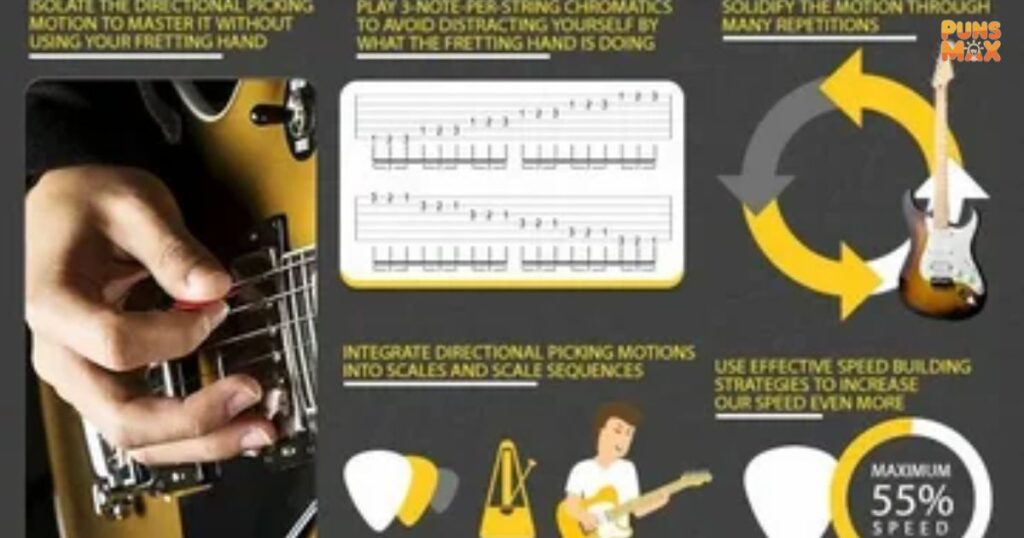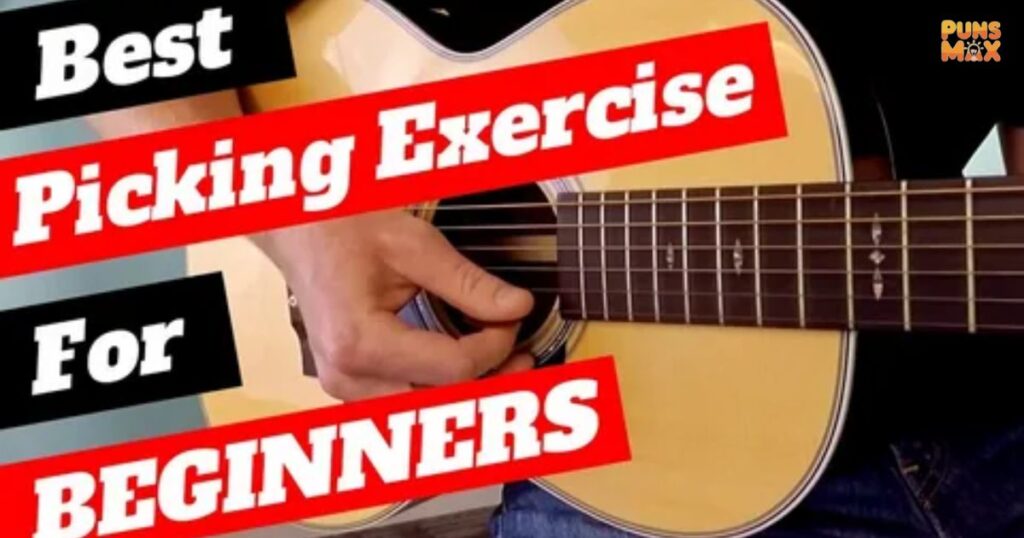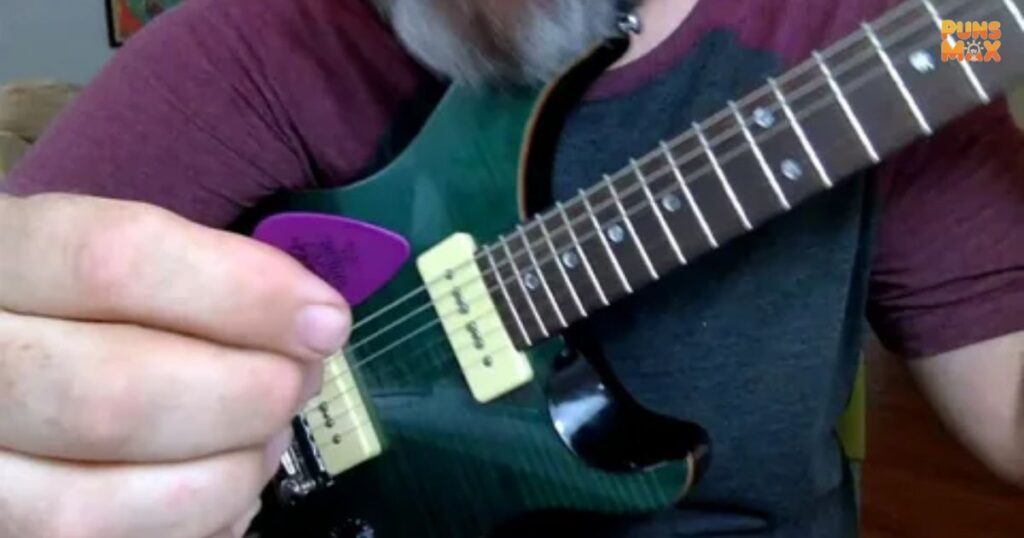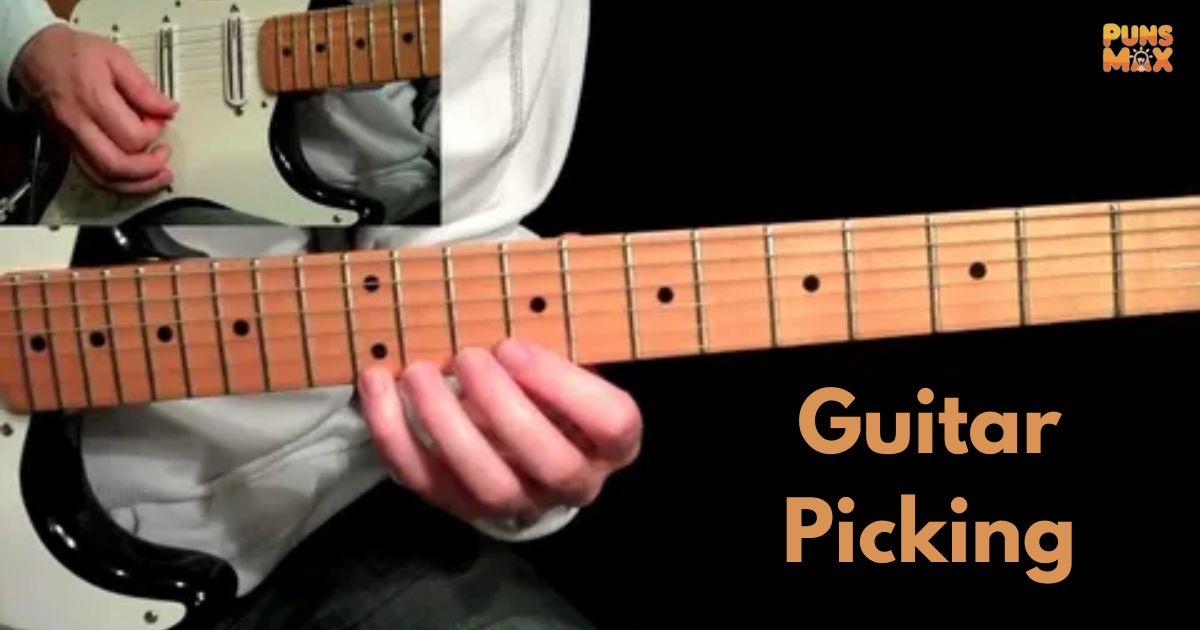Imagine playing your guitar with smooth, clean, and powerful notes that instantly grab attention. The secret behind that sound is often one skill guitar picking. Whether you’re just starting or already playing but struggling with speed and accuracy, improving your picking will transform your music.
In this guide, we’ll make guitar picking simple by covering basic techniques, easy exercises, and useful fingerpicking patterns. You’ll also learn beginner-friendly tips on guitar fingerpicking for beginners, explore different finger picking patterns, and discover creative guitar fingerpicking patterns used by pros. With practice, these fingerpicking patterns guitar players rely on will help you build speed, accuracy, and confidence every time you play.
What is Guitar Picking

- Guitar picking means giving strings a voice, turning vibration into pure melody magic.
- Without picking, the guitar is silent—an unread book waiting for attention.
- Picking is simply asking strings to speak, kindly requesting stories through sound.
- A pick stroke is a spark, igniting the campfire of musical expression.
- Picking is language; each pluck a word, each rhythm a meaningful sentence.
- Strings hum with excitement, waiting for picking to give them meaningful conversations.
- Guitar picking is like knocking—every stroke opens a new musical door.
- To pick is to breathe life into wood, wire, and vibrating air.
- Picking is balance: soft or strong, whisper or roar, storyteller or listener.
- Guitar picking is like steering; it directs the song where it must go.
- Picking transforms random vibrations into patterns we proudly call songs and rhythms.
- Picking teaches patience; every stroke builds muscle memory and melodic understanding.
- Without picking, a guitar is a bird unable to spread melodic wings.
- A simple pick stroke can launch hearts into flight through songs of beauty.
- Picking creates pulse, rhythm, and groove—like footsteps keeping time in music’s journey.
- To pick is to create balance between control and freedom in music.
- Picking gives shape to silence, sculpting melodies into clear emotional landscapes.
- A pick is the key, unlocking doors to infinite musical styles.
- Picking is rhythm’s anchor, melody’s friend, and harmony’s quiet but steady guide.
- Without picking, music remains unspoken, waiting like poetry hidden inside dusty pages.
- Picking is simple yet powerful, the spark that ignites every musical flame.
- A pick transforms nervous trembles into confident rhythms carrying songs across hearts.
- Picking defines the difference between noise and music, chaos and beautiful order.
Read More: 220+Superman Ice Cream: A Colorful Scoop of Fun for All Ages
Fingerstyle vs. Flatpicking
- Fingerstyle has many voices; flatpicking is one strong leader guiding the band.
- Fingerstyle whispers secrets; flatpicking shouts proudly, each bringing unique stories through sound.
- Fingerstyle is painting with brushes; flatpicking is painting with bold wide strokes.
- Flatpicking sings loud songs; fingerstyle creates choirs from one guitar’s humble voice.
- Fingerstyle uses every finger like dancers; flatpicking is a single spotlight performance.
- Flatpicking is bold lightning; fingerstyle is soft rain—each carries different musical beauty.
- Fingerstyle is weaving; flatpicking is hammering—both build strong houses of musical expression.
- Flatpicking gives speed; fingerstyle gives texture—each style offers its own strengths.
- Fingerstyle feels like conversation; flatpicking feels like storytelling with powerful clear voice.
- Fingerstyle is an orchestra; flatpicking is a trumpet leading melody confidently.
- Flatpicking builds solos; fingerstyle builds harmonies—together, they make complete music stories.
- Fingerstyle is detailed embroidery; flatpicking is bold fabric cut for clarity.
- Flatpicking is an arrow; fingerstyle is a web—both purposeful in design.
- Fingerstyle offers color; flatpicking gives shine—two styles with unique sound worlds.
- Flatpicking thrives in speed; fingerstyle thrives in layers—both challenging and rewarding.
- Fingerstyle gives freedom; flatpicking gives focus—music needs both approaches to thrive.
- Flatpicking is sprinting; fingerstyle is dancing—two rhythms, same road, different journeys.
- Fingerstyle paints clouds; flatpicking paints lightning—contrast defines beauty in guitar playing.
- Flatpicking gives direct hits; fingerstyle sprinkles subtlety—each serves songs uniquely.
- Fingerstyle feels like weaving stories; flatpicking feels like narrating with bold clarity.
- Flatpicking is lightning strike precision; fingerstyle is soft candlelight glow—both inspire awe.
- Fingerstyle and flatpicking aren’t rivals—they’re teammates making guitar beautifully versatile.
- Choosing between fingerstyle and flatpicking is like choosing flavors—both deliciously rewarding.
Easy Ways to Pick Faster

- Picking faster is running a marathon—small daily steps lead to great speed.
- Relaxed fingers always travel faster than stiff ones locked in musical tension.
- Picking speed comes with patience; rushing practice only slows progress in long run.
- To play faster, think lighter—speed loves relaxed wrists and calm minds.
- Picking faster is training birds; wings need practice before soaring freely through skies.
- A metronome is speed’s teacher, gently pushing players towards smoother, quicker precision.
- Picking fast isn’t about strength—it’s about the economy of movement and control.
- To gain speed, first slow down—clarity builds foundation before flying with rhythm.
- Faster picking grows like trees: steady water, sunlight, and consistent daily care.
- Picking quick is dancing on strings—graceful movements always beat rushed stumbling.
- Speed hides in tiny steps, one clean note at a practiced time.
- Picking faster means shortening travel—small finger motions always beat wide flailing movements.
- Fast picking isn’t magic—it’s practice multiplied by patience and steady discipline.
- A speedy hand learns through repetition; every stroke teaches muscles to trust.
- Picking faster is chasing wind—capture it with lightness, not with stubborn force.
- Speed is built by layers: first clarity, then rhythm, finally lightning bursts.
- Picking faster comes when tension leaves—loosen grip and let music breathe.
- A relaxed wrist becomes the highway where speed cars travel without crashing.
- Picking speed grows invisible at first—then suddenly blooms like spring flowers.
- Picking faster is catching butterflies—gentle technique always succeeds where force fails.
- True speed comes not from rushing, but from flowing smoothly like rivers.
- Speedy picking is puzzle-solving; remove wasted motion, and efficiency reveals faster patterns.
- To play fast, play mindful—every precise motion builds tomorrow’s lightning solos.
Alternate Picking Basics
- Alternate picking is walking: left, right, down, up—balance creates smooth forward motion.
- Downstrokes bring weight, upstrokes bring lift—together they create musical flight patterns.
- Alternate picking is pendulum swinging; rhythm lies in equal back-and-forth strokes.
- Each stroke’s partner waits—down calls up, up calls down, like rhythmic conversation.
- Alternate picking is breathing: inhale, exhale; down, up—constant flow sustains musical life.
- Mastering alternate picking is taming waves, riding both directions without losing balance.
- Down and up strokes are puzzle pieces; together they form musical pictures.
- Alternate picking whispers efficiency: two directions are faster than one stubborn path.
- A downstroke alone marches; an upstroke alone skips—together, they dance gracefully.
- Alternate picking is rowing a boat; each stroke balances the opposite.
- Without alternate picking, solos stumble; with it, they glide smoothly across fretboards.
- Alternate strokes are footsteps—consistent, even, and guiding songs steadily forward.
- Each downstroke sets up an upstroke; cooperation creates beautiful rhythmic teamwork.
- Alternate picking is a swing ride—back and forth keeps rhythm alive.
- Precision in alternate picking is like writing—each letter builds fluent sentences.
- Down-up strokes are heartbeats—steady rhythm keeps music alive and beating strong.
- Alternate picking is a seesaw; balance brings smooth continuous motion forward.
- Without alternate picking, speed feels clumsy; with it, fluidity finally blossoms.
- Each alternate stroke is a handshake—cooperation creates music’s flowing partnership.
- Alternate picking builds bridges—connecting fast scales with clarity and equal strokes.
- Practicing alternate picking is sharpening tools; smoothness and sharpness create perfect cuts.
- Down strokes alone speak loudly; up strokes alone whisper softly—together they harmonize.
- Alternate picking is music’s bicycle—once balance is learned, momentum carries you effortlessly.
Picking Exercises for Beginners

- Start with single strings; every note picked cleanly builds future musical strength.
- Beginner exercises are seeds; small, repeated efforts grow into great skill trees.
- Pick open strings slowly—clarity first, speed later, mastery always follows patience.
- Finger and pick coordination is handshake practice—strong grip makes smoother friendship later.
- Simple picking drills are bricks; together they build strong castles of technique.
- Beginners must love repetition; it’s the rhythm that turns confusion into clarity.
- Practice picking like tying shoes—slow, careful, then natural and effortless forever.
- One string at a time teaches focus, removing chaos from early practice.
- Simple exercises are mirrors—reflecting mistakes honestly and guiding improvement gradually.
- Practicing daily is watering plants; without care, skills wither into silent strings.
- Start small: four notes, alternate strokes—repeat until confidence sings naturally.
- Beginners thrive on patience; rushing leads only to frustration and messy rhythms.
- Simple drills are stepping stones; each one brings you closer to mastery.
- Picking practice is brushing teeth—small, daily habit prevents large musical problems.
- Play with metronome—your time-keeping partner ensuring rhythm grows steady.
- Clean strokes matter more than speed—focus builds unshakable technique foundations.
- Mistakes are friendly teachers; beginners learn by repeating until errors transform.
- Picking exercises are ladders; each rung climbed builds stronger musical confidence.
- Beginners must learn relaxed grip—tension kills music before it even begins.
- Daily practice is compass; consistency always points toward brighter musical horizons.
- Picking exercises are puzzles; patience solves them piece by piece.
- Clean picking is painting outlines; later, advanced techniques color the canvas.
- Begin gently, build steadily—mastery grows silently while practicing humble exercises.
Read More: 165+Medicinal Plants Discover Nature’s Best Remedies for Everyday Health
Boost Speed & Accuracy
- Speed without accuracy is running fast blindfolded—you’ll crash before arriving anywhere.
- Accuracy sharpens speed like polishing glass—clear precision makes motion shine brightly.
- Boosting speed means trimming wasted motion—less movement always equals faster clean notes.
- Accuracy builds trust; every note lands exactly where listeners expect beautiful sound.
- True speed is calm inside; panic slows hands while rhythm flows.
- Accuracy is compass, speed is engine—together they guide music straight forward.
- Practice slow, gain accuracy—later, tempo increases naturally like sunrise each morning.
- Speed thrives on repetition; accuracy thrives on mindfulness—together, they form mastery.
- Accurate picking is writing neatly; speed makes the sentences read faster.
- Speedy accuracy means notes land like raindrops—perfect, even, and beautifully refreshing.
- Without accuracy, speed is chaos; with both, music flows like rivers.
- Speed and accuracy are twins—nurture them equally to build strong technique.
- Accuracy trains muscles; speed rewards patience with flowing, effortless movement.
- A metronome trains both—steady ticking builds speed and precision hand-in-hand.
- Accuracy builds trust with listeners; speed builds excitement, together creating balance.
- Speed and accuracy balance like tightrope walkers—steady focus keeps them safe.
- Each accurate stroke is seed; speed waters it, creating blooming rhythm.
- Speed thrills crowds, accuracy comforts hearts—together they form powerful performances.
- To boost both, practice carefully; sloppiness grows faster than skill unchecked.
- Speed loves relaxed motion; accuracy loves careful control—both reward patient practice.
- Accuracy is bow, speed is arrow—both needed to hit musical target.
- Fast without clean notes is noise; clean plus fast equals magic.
- Speed and accuracy build bridges—strong enough to carry beautiful songs safely.
Common Picking Mistakes

- Gripping the pick too tight turns music into fighting rather than flowing.
- Forgetting wrist relaxation stiffens tone; loose wrists sing with smoother sounds.
- Ignoring the metronome makes the rhythm wobbly, like walking without steady footprints behind.
- Picking only downstrokes stalls progress; alternate strokes fuel faster, smoother journeys.
- Rushing tempo hides mistakes temporarily; patience reveals strong long-term improvement.
- Holding pick sideways dull tone; proper angle sharpens sound and clarity.
- Tensing shoulders drains energy; relaxed posture lets picking feel natural.
- Beginners often chase speed before accuracy; foundation crumbles without careful building.
- Playing without focus multiplies errors; mindful practice builds confident, clean results.
- Forgetting dynamics flattens songs—picking should breathe, not sound like machines.
- Moving fingers too far wastes time; economy of motion brings efficiency.
- Ignoring mistakes is planting weeds; fix early before garden of music suffers.
- Over-practicing without breaks burns hands; rest grows strength like sleep strengthens bodies.
- Avoid watching left hand constantly; trust muscle memory for smoother flow.
- Failing to warm up strains fingers; gentle stretches prevent painful problems.
- Using heavy pick too early makes control difficult; lighter helps learning.
- Beginners often forget rhythm is king; tone without timing loses impact.
- Skipping basics invites trouble; strong roots keep musical tree standing tall.
- Avoid copying bad habits; imitate clean players, not flashy shortcuts.
- Don’t ignore volume control; uneven picking distracts listeners from melody’s beauty.
- Tension in thumb reduces flexibility; loosen grip to unlock smoother motion.
- Lack of patience ruins progress; time is key to long-term skill.
- Mistakes aren’t failures—they’re guides showing exactly where improvement needs attention.
Acoustic vs. Electric Picking
- Acoustic picking sings warm campfires; electric picking shouts bright stadium anthems loudly.
- Acoustic thrives on resonance; electric thrives on clarity—each offers unique beauty.
- Acoustic strings reward gentleness; electric strings respond quickly to lightning-fast picking.
- Acoustic playing is painting landscapes; electric playing is painting neon skylines.
- Acoustic picking builds endurance; electric picking builds precision with amplified articulation.
- Acoustic whispers natural tones; electric adds spice with effects and distortion.
- Acoustic strings require control; electric strings demand accuracy—both challenge players differently.
- Acoustic flourishes unplugged; electric thrives wired—two worlds, same instrument, different magic.
- Acoustic songs feel like diaries; electric songs feel like headlines.
- Acoustic emphasizes dynamics; electric emphasizes speed—each excites audiences uniquely.
- Acoustic picking echoes tradition; electric picking fuels innovation—both inspire players worldwide.
- Acoustic sounds like wood breathing; electric sounds like lightning striking.
- Acoustic thrives on subtle touch; electric thrives on bold execution.
- Acoustic picking builds storytelling; electric picking builds showmanship—both essential sides of music.
- Acoustic resonates naturally; electric relies on gear—each paints with unique colors.
- Acoustic solos breathe life slowly; electric solos burn trails across sky.
- Acoustic rewards patience; electric rewards daring—both teach balance in technique.
- Acoustic songs connect intimately; electric songs explode energetically—two moods from one heart.
- Acoustic picking challenges endurance; electric picking tests control—skills grow through both.
- Acoustic speaks with whispers; electric speaks with megaphones—both deliver strong messages.
- Acoustic shines unplugged simplicity; electric thrives in powerful complexity.
- Acoustic bonds with folk tradition; electric bonds with rock rebellion—both carve history.
- Acoustic and electric aren’t rivals—they’re siblings sharing music’s powerful universal language.
Famous Picking Styles

- Travis picking feels like clockwork—steady patterns tick time into beautiful melodies.
- Gypsy jazz picking is fire—fast, fiery strokes blazing trails across strings.
- Bluegrass flatpicking gallops like horses, racing notes across wide-open musical landscapes.
- Flamenco picking claps rhythms, each stroke exploding with passionate Spanish storytelling.
- Classical fingerpicking paints portraits—careful, precise strokes create timeless elegance.
- Country chicken-picking twangs cheerfully, making every string laugh with bright humor.
- Blues picking bends notes—tears and smiles flowing together in soulful conversation.
- Funk picking scratches grooves—rhythms bounce like shoes on crowded dancefloors.
- Jazz picking flows endlessly, like rivers weaving complex patterns of harmony.
- Rock picking strikes boldly, each note a thunderclap across amplified skies.
- Folk fingerpicking tells stories—campfires glowing brighter with every gentle pluck.
- Metal shredding picking screams lightning-fast, setting strings ablaze with fiery precision.
- Celtic picking dances lively, weaving melodies like ancient traditions spinning forever.
- Ragtime picking hops cheerfully, playful syncopation bouncing joyfully on guitar.
- Pop picking sparkles brightly, catching ears instantly with catchy rhythm patterns.
- Surf picking splashes soundwaves, making guitars sound like rolling coastal tides.
- Latin picking shakes hips, rhythms swirling like carnival parades on strings.
- Swing picking bounces smooth, rhythm swinging easy like dancers on ballroom floors.
- Gospel picking lifts spirits, every stroke a prayer of joyful praise.
- Reggae picking chops rhythm, steady offbeats glowing like sunshine in sound.
- Flamenco rasgueado picking burns, fiery strums exploding like sparks from fire.
- Hawaiian picking flows smoothly, melodies floating gently like waves on shore.
- Famous styles remind us: every picking tradition writes its own story.
Read More: 190+Sudarshan Kriya – Powerful Breathing Technique for Stress Relief & Inner Peace
Advanced Picking Patterns
- Sweep picking cascades notes like waterfalls, flowing smoothly without breaking momentum.
- Hybrid picking blends fingers with pick, adding texture and lightning-fast complexity.
- Crosspicking rolls notes like waves, creating arpeggios shimmering continuously.
- Economy picking trims motion, combining speed with graceful economy of effort.
- String skipping leaps joyfully, creating melodic jumps across unexpected distances.
- Harmonic picking sparkles, ringing notes like bells chiming crystal-clear tones.
- Tapping blends picking with hammering, strings singing futuristic voices.
- Tremolo picking buzzes quickly, notes fluttering like hummingbird wings in rhythm.
- Polyrhythmic picking puzzles ears, creating complex but beautiful rhythmic illusions.
- Artificial harmonic picking whispers, ghostly tones haunting every phrase.
- Double-stop picking strengthens voices, harmonies growing from two strings together.
- Sweep arpeggios paint staircases, climbing smoothly across entire fretboards.
- Pinch harmonics squeal joyfully, guitars shouting squeaks like playful tricks.
- Hybrid patterns mix techniques—players craft limitless possibilities with creativity.
- Gallop picking races forward, rhythms pounding like wild horses running free.
- Percussive picking slaps strings, guitar turning into drum kit instantly.
- Sweep tapping dazzles, blending waterfalls with lightning bolts simultaneously.
- Fast octave picking doubles melodies, echoing voices singing across registers.
- Tremolo triplets create textures, shimmering waves flowing endlessly through time.
- Advanced patterns challenge patience—small victories multiply into monumental progress.
- Complex picking feels like puzzles—solving unlocks beauty hidden beneath surface.
- Unusual time signatures stretch picking—new rhythms shape unfamiliar but exciting sounds.
- Mastering advanced picking patterns expands the voice—guitar becomes a full orchestra.
Conclusion
In the end, guitar picking is the key to clean, fast, and expressive playing. By practicing simple fingerpicking patterns and building up from easy finger picking patterns, you’ll notice steady progress in your control and sound. If you’re new, starting with guitar fingerpicking for beginners is the best way to gain confidence before moving to advanced levels.
Even professional players grew by repeating the basics daily working on guitar fingerpicking patterns and refining their fingerpicking patterns guitar skills. With patience, consistency, and the right exercises, your picking will soon feel smooth, accurate, and natural. Keep practicing, trust the process, and let your passion for music lead the way.

